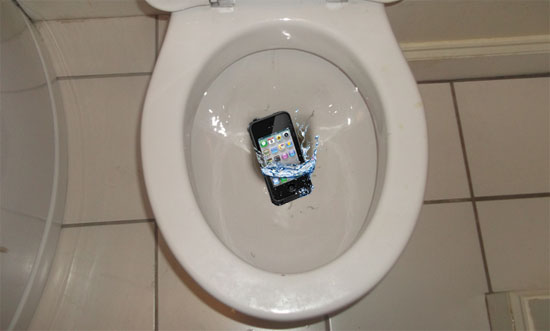Save a Wet Phone
A great original article from Mat Greenfield at CNET
- Firstly, retrieve your handset from the drink right away. A prolonged plunge will increase the risk of damage.
- Resist the urge to check if it still works or press any buttons, since putting pressure on the keys could shift liquid farther into the device.
- In all cases, the best thing to do is immediately pull out the battery, thus minimizing power to the device that may cause it to short circuit.
- If you own a handset with a non-replaceable battery, like an iPhone or Nokia Lumia, then pulling the battery isn’t an option. You’ll have to risk pressing a few buttons to check if it’s still on and to swiftly turn it off if it is. Take care when handling the phone in this case.
- Remove any peripherals and attachments on your phone, such as cases.
- Extract the SIM card and any SD cards it carries, leaving ports or covers on your handset open to aid ventilation.
- Dry off everything with a towel, including the exterior of your handset, being careful not to let any water drain into openings on the phone.
- Even when everything’s dry, it’s very likely there’s latent moisture within the device that you’ll want to get out before turning it on. The most oft-reported fix for a sodden phone is to bury the handset in a bowl of dry rice. Desiccant materials, such as rice, have hygroscopic properties that can attract and absorb moisture. You can also use silica gel packs — the kind used in shoe boxes — to greater effect. If you don’t have any lying around, uncooked rice will do nicely.Silica gel packs work best for drying out a phone.
- Place your phone in an airtight container and completely cover it with your choice of desiccant. Leave the container for 24 to 48 hours for the material to draw all the moisture out of your handset. If you feel like splashing out, you can buy silica-lined, hermetically sealed pouches that are specifically designed for the task.
- When you’re confident it’s dried out, replace the battery and try switching it on. Good luck!
What not to do
A purported fast-track method of drying out a wet phone is to use a hairdryer, or applying heat to the device in other ways. While this would successfully evaporate all the moisture still sitting within the handset, it risks becoming too hot and causing damage to the components.
In cases of severe water logging, the steam created may not be able to fully ventilate and would simply condense again elsewhere in the phone. You may get away with it, but it seems rather perilous, so my recommendation is to avoid this method.
Another recurring recommendation is to stick your phone in a freezer, wrapped in paper towel to prevent frost damage. Supposedly, the reduced conductivity of water when close to freezing temperatures will stop your phone from short circuiting when in use.
This is definitely not a long-term solution, however, since as soon as the ice begins to thaw, you’re left with the same, if not exacerbated, problem. In the process you’ll probably mess up your phone’s very fragile screen, which hardly seems worth risking for a short-term fix of dubious effectiveness.
For less-severe dunkings, you may get away with drying your phone thoroughly on the exterior alone, paying special attention to openings like the headphone jack and USB port. To this end, a few have suggested gently poking into them with a toothpick wrapped in paper towel. While jabbing into your phone with a stick is always a bit iffy, the biggest risk is that rags of sodden paper could get stuck inside your phone and play havoc with its innards.
One suggestion is to overcharge the handset so that the build-up of heat is gradual and not excessive, but this carries all the risks you’d expect with running a current through wet circuitry.
Inevitably, someone reading this will wonder if it’s possible to dry out a phone by putting it in the microwave. Do that, and may Darwin have mercy.


It’s truly a nice and helpful piece of information. I am happy that you simply shared this helpful information with
us. Please stay us up to date like this. Thank
you for sharing.
I have learn several excellent stuff here. Definitely price bookmarking for revisiting. I surprise how so much attempt you set to create such a magnificent informative website.
Hey There. I found your blog using msn. This is a really well written article. I will make sure to bookmark it and return to read more of your useful info. Thanks for the post. I will definitely return.
Good day! This is my 1st comment here so I just wanted to give a quick shout out and say I truly enjoy reading your blog posts. Can you recommend any other blogs/websites/forums that go over the same topics? Thanks for your time!
true religion outlet http://realtycolorado.com/bloghtml/
Heya i am for the first time here. I came across this board and I to find It truly useful & it helped me out much. I am hoping to give one thing back and aid others such as you helped me.
Very soon this web page will be famous among all blog people, due to it’s fastidious content